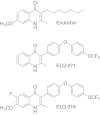Endochin-like quinolones are highly efficacious against acute and latent experimental toxoplasmosis
- PMID: 23019377
- PMCID: PMC3465437
- DOI: 10.1073/pnas.1208069109
Endochin-like quinolones are highly efficacious against acute and latent experimental toxoplasmosis
Abstract
Toxoplasma gondii is a widely distributed protozoan pathogen that causes devastating ocular and central nervous system disease. We show that the endochin-like quinolone (ELQ) class of compounds contains extremely potent inhibitors of T. gondii growth in vitro and is effective against acute and latent toxoplasmosis in mice. We screened 50 ELQs against T. gondii and selected two lead compounds, ELQ-271 and ELQ-316, for evaluation. ELQ-271 and ELQ-316, have in vitro IC(50) values of 0.1 nM and 0.007 nM, respectively. ELQ-271 and ELQ-316 have ED(50) values of 0.14 mg/kg and 0.08 mg/kg when administered orally to mice with acute toxoplasmosis. Moreover, ELQ-271 and ELQ-316 are highly active against the cyst form of T. gondii in mice at low doses, reducing cyst burden by 76-88% after 16 d of treatment. To investigate the ELQ mechanism of action against T. gondii, we demonstrate that endochin and ELQ-271 inhibit cytochrome c reduction by the T. gondii cytochrome bc(1) complex at 8 nM and 31 nM, respectively. We also show that ELQ-271 inhibits the Saccharomyces cerevisiae cytochrome bc(1) complex, and an M221Q amino acid substitution in the Q(i) site of the protein leads to >100-fold resistance. We conclude that ELQ-271 and ELQ-316 are orally bioavailable drugs that are effective against acute and latent toxoplasmosis, likely acting as inhibitors of the Q(i) site of the T. gondii cytochrome bc(1) complex.
Conflict of interest statement
The authors declare no conflict of interest.
Figures




Similar articles
-
Targeted Structure-Activity Analysis of Endochin-like Quinolones Reveals Potent Qi and Qo Site Inhibitors of Toxoplasma gondii and Plasmodium falciparum Cytochrome bc1 and Identifies ELQ-400 as a Remarkably Effective Compound against Acute Experimental Toxoplasmosis.ACS Infect Dis. 2018 Nov 9;4(11):1574-1584. doi: 10.1021/acsinfecdis.8b00133. Epub 2018 Aug 30. ACS Infect Dis. 2018. PMID: 30117728 Free PMC article.
-
Orally Bioavailable Endochin-Like Quinolone Carbonate Ester Prodrug Reduces Toxoplasma gondii Brain Cysts.Antimicrob Agents Chemother. 2020 Aug 20;64(9):e00535-20. doi: 10.1128/AAC.00535-20. Print 2020 Aug 20. Antimicrob Agents Chemother. 2020. PMID: 32540978 Free PMC article.
-
Genetic Evidence for Cytochrome b Qi Site Inhibition by 4(1H)-Quinolone-3-Diarylethers and Antimycin in Toxoplasma gondii.Antimicrob Agents Chemother. 2017 Jan 24;61(2):e01866-16. doi: 10.1128/AAC.01866-16. Print 2017 Feb. Antimicrob Agents Chemother. 2017. PMID: 27919897 Free PMC article.
-
Perspective on current and emerging drugs in the treatment of acute and chronic toxoplasmosis.Postgrad Med. 2019 Nov;131(8):589-596. doi: 10.1080/00325481.2019.1655258. Epub 2019 Aug 26. Postgrad Med. 2019. PMID: 31399001 Review.
-
New antibacterials for the treatment of toxoplasmosis; a patent review.Expert Opin Ther Pat. 2012 Mar;22(3):311-33. doi: 10.1517/13543776.2012.668886. Epub 2012 Mar 10. Expert Opin Ther Pat. 2012. PMID: 22404108 Review.
Cited by
-
The Heptaprenyl Diphosphate Synthase (Coq1) Is the Target of a Lipophilic Bisphosphonate That Protects Mice against Toxoplasma gondii Infection.mBio. 2022 Oct 26;13(5):e0196622. doi: 10.1128/mbio.01966-22. Epub 2022 Sep 21. mBio. 2022. PMID: 36129297 Free PMC article.
-
Development of an Orally Available and Central Nervous System (CNS) Penetrant Toxoplasma gondii Calcium-Dependent Protein Kinase 1 (TgCDPK1) Inhibitor with Minimal Human Ether-a-go-go-Related Gene (hERG) Activity for the Treatment of Toxoplasmosis.J Med Chem. 2016 Jul 14;59(13):6531-46. doi: 10.1021/acs.jmedchem.6b00760. Epub 2016 Jul 1. J Med Chem. 2016. PMID: 27309760 Free PMC article.
-
Urolithin-A attenuates neurotoxoplasmosis and alters innate response towards predator odor.Brain Behav Immun Health. 2020 Aug 11;8:100128. doi: 10.1016/j.bbih.2020.100128. eCollection 2020 Oct. Brain Behav Immun Health. 2020. PMID: 34589880 Free PMC article.
-
Biochemical Studies of Mitochondrial Malate: Quinone Oxidoreductase from Toxoplasma gondii.Int J Mol Sci. 2021 Jul 22;22(15):7830. doi: 10.3390/ijms22157830. Int J Mol Sci. 2021. PMID: 34360597 Free PMC article.
-
Building Programs to Eradicate Toxoplasmosis Part I: Introduction and Overview.Curr Pediatr Rep. 2022;10(3):57-92. doi: 10.1007/s40124-022-00269-w. Epub 2022 Aug 22. Curr Pediatr Rep. 2022. PMID: 36034212 Free PMC article. Review.
References
-
- Jones JL, Kruszon-Moran D, Sanders-Lewis K, Wilson M. Toxoplasma gondii infection in the United States, 1999 2004, decline from the prior decade. Am J Trop Med Hyg. 2007;77:405–410. - PubMed
-
- Arevalo JF, Belfort R, Jr, Muccioli C, Espinoza JV. Ocular toxoplasmosis in the developing world. Int Ophthalmol Clin. 2010;50:57–69. - PubMed
-
- Mulanovich VE, et al. Toxoplasmosis in allo-SCT patients: Risk factors and outcomes at a transplantation center with a low incidence. Bone Marrow Transplant. 2011;46:273–7. - PubMed
-
- Porter SB, Sande MA. Toxoplasmosis of the central nervous system in the acquired immunodeficiency syndrome. N Engl J Med. 1992;327:1643–1648. - PubMed
-
- Renold CAS, et al. Toxoplasma encephalitis in patients with the acquired immunodeficiency syndrome. Medicine (Baltimore) 1992;71:224–239. - PubMed
Publication types
MeSH terms
Substances
Grants and funding
LinkOut - more resources
Full Text Sources
Other Literature Sources
Medical
Molecular Biology Databases

